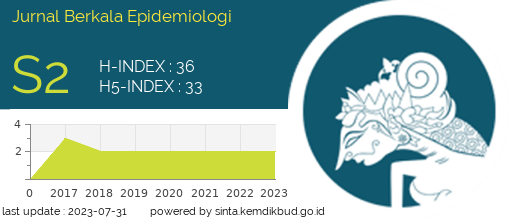THE CORRELATION BETWEEN EXERCISE ACTIVITY, GENETIC BACKGROUND, FAST FOOD CONSUMPTION, AND DYSMENORRHEA
Downloads
Background: Most women in Indonesia have experienced dysmenorrhea (54.89%). One of the factors that influence dysmenorrhea is low preventive measures carried out by women such as lack of exercise activity, genetic background, and consumption of fast food. Purpose: This study aims to analyze the correlation between exercise activity, genetic background, and fast food consumption and dysmenorrhea. Method: This study was an analytic observational study with a cross-sectional research design. The research population included the students of Public Health Faculty who had menstruated. The samples were 108 respondents chosen by random sampling technique. The variables examined in this study were genetic background, exercise activity, and fast food consumption and the occurrence of dysmenorrhea. Data collection was carried out in February 2019. The research location was at the Faculty of Public Health, Universitas Airlangga, Surabaya. The data were analyzed using univariate and bivariate analysis based on the chi-square test results. Result: The prevalence of dysmenorrhea experienced by students of Public Health Faculty was 65.70%. The test results showed no correlation between exercise activity and dysmenorrhea (p = 0.47), there was a correlation between dysmenorrhea and genetic background (p = 0.01) and there was no correlation between consumption of fast food and dysmenorrhea (p = 0.53). Conclusion: The study shows the there is a correlation between genetic background and dysmenorrhea. On the other hand, there is no correlation between exercise activity and the consumption of fast food with the occurrence of dysmenorrhea.
Agustini, F. U. (2017). Relationship between eating habits, physical activity, and nutritional status with the incidence of dysmenorrhea in female students PPKU IPB. Undergraduated Thesis. Faculty of Human Ecology. Institut Pertanian Bogor.
Ammar, U. R. (2016). Primary risk factors for dysmenorrhea in women of childbearing age in the Village of Ploso, Tambakari Sub-district, Surabaya. Jurnal Berkala Epidemiologi, 4(1), 37–49. https://doi.org/10.20473/jbe.v4i1.37-49
Cholifah, & Hadikasari, A. A. (2015). Relationship between anemia, nutritional status, exercise, and knowledge with the incidence of dysmenorrhea in young women. Midwiferia, 1(1), 31–43. https://doi.org/10.21070/mid.v1i1.346
Fahimah, Margawati, A., & Fitranti, D. Y. (2017). Relationship between consumption of omega-3 fatty acids, physical activity and percent body fat with levels of dysmenorrhea in adolescents. Journal of Nutrition College, 6(4), 268–276.
Faramarzi, M., & Salmalian, H. (2014). Association of psychologic and nonpsychologic factors with primary dysmenorrhea. Iranian Red Crescent Medical Journal, 16(8), 1–9. https://doi.org/10.5812/ircmj.16307
Farasati, N., Siassi, F., Koohdani, F., Qorbani, M., Abashzadeh, K., & Sotoudeh, G. (2015). Western dietary pattern is related to premenstrual syndrome: a case–control study. British Journal of Nutrition, 114(12), 1–6. https://doi.org/10.1017/s0007114515003943
Halpern, G., Schor, E., & Kopelman, A. (2016). Nutritional aspects related to endometriosis. Revista Da Associaçí£o Médica Brasileira, 61(6), 519–523. https://doi.org/10.1590/1806-9282.61.06.519
Handayani, E. Y., & Rahayu, L. S. (2014). Faktor- Factors that associated with menstrual pain (dysmenorrhoea) in young women in several high schools in Rokan Hulu Regency. Jurnal Maternity and Neonatal, 1(4), 161–171.
Ibrahim, N. K., Alghamdi, M. S., Al-Shaibani, A. N., Alamri, F. A., Alharbi, H. A., Al-Jadani, A. K., & Alfaidi, R. A. (2015). Dysmenorrhea among female medical students in king abdulaziz university: prevalence, predictors and outcome. Pakistan Journal of Medical Sciences, 31(6), 1312–1317. https://doi.org/10.12669/pjms.316.8752
Indahwati, A. N., Muftiana, E., & Purwaningroom, D. L. (2017). Relationship between eating fast food (fast food) and the incidence of dysmenorrhea in young women at Ponorogo "1" Junior High School. Indonesian Journal for Health Sciences, 1(2), 7–13. https://doi.org/10.24269/ijhs.v1i2.2017.4
Indonesian Central Bureau of Statistics. (2013). Projected Population of Indonesia 2010-2035. Jakarta: Indonesian Central Bureau of Statistics.
Kazama, M., Maruyama, K., & Nakamura, K. (2015). Prevalence of dysmerorrhea and its correlating lifestyle factors in Japanese Female Junior High School Students. The Tohoku Journal of Experimental Medicine, 236(2), 107–113. https://doi.org/10.1620/tjem.236.107
Khairunnisa, & Maulina, N. (2018). Relationship between physical activity and menstrual pain (dysmenorrhoea) in female students of Ulumuddin Private Islamic School Uteunkot Conda Lhokseumawe City. Averrous, 3(1), 10–20.
Kristianingsih, A. (2016). Primary risk factors of dysmenorrhea at junior high school students in Natar Subdistrict, South Lampung Regency. Jurnal Aisyah: Jurnal Ilmu Kesehatan, 1(1), 19–27. https://doi.org/10.30604/jika.v1i1.4
Kusmindarti, I., & Munadlifah, S. (2016). Relationship between exercise habits and dysmenorrhea incidence at young women in the Aerobic Gymnastics Community of Dr. Tri Widodo Basuki Jabon Mojoanyar Mojokerto. Jurnal Kebidanan, 5(1), 1–6.
Larasati, T., & Alatas, F. (2015). Primary dysmenorrhea and risk factors for primary dysmenorrhea in adolescents. Majoritiy, 5(3), 79–84.
Mohapatra, D., Mishra, T., Behera, M., & Panda, P. (2017). A study of relation between body mass index and dysmenorrhea and its impact on daily activities of medical students. Asian Journal of Pharmaceutical and Clinical Research, 9(3), 297–299. https://doi.org/10.22159/ajpcr.2016.v9s3.14753
Novita, R. (2018). Relationship between nutritional status and menstrual disorders in young women at Al-Azhar High School Surabaya. Amerta Nutrition, 2(2), 172–181. https://doi.org/10.20473/amnt.v2.i2.2018.172-181
Pejcˇic, A., & Jankovic, S. (2016). Contrasting the anti-vaccine prejudice: a public health perspective. Ann Ist Super Sanití , 52(1), 98–103. https://doi.org/10.4415/ANN_16_01_16
Pramanik, P., & Dhar, A. (2014). Impact of fast food on menstrual helath of school going adolescent girls in West Bengal, Eastern India. Global Journal of Biology, Agriculture and Health Sciences, 3(1), 61–66.
Rahayu, A., Pertiwi, S., & Patimah, S. (2017). Effect of endorphine massage on the pain of dysmenorrhea at midwifery polytechnic students of the Ministry of Health of Tasikmalaya in 2017. Jurnal Bidan "Midwife Journal,” 3(2), 22–30.
Rakhma, A. (2012). An overview of the degree of dysmenorrhea and its handling efforts on the Arjuna Depok High School Vocational Students in West Java. Undergraduated Thesis. Faculty of Medicine and Health Sciences. Universitas Islam Negeri Syarif Hidayatullah Jakarta.
Sakinah. (2016). Factors related to the incidence of primary dysmenorrhea in adolescents. Undergraduated Thesis. Faculty of Human Ecology. Institut Pertanian Bogor.
Savanthe, A., & Nanjundappa, V. (2015). Menstruation: a cross-sectional study on knowledge, belief, and practices among adolescent girls of junior colleges, Kuppam, Andhra Pradesh. International Journal of Medical Science and Public Health, 5(1), 22–27. https://doi.org/10.5455/ijmsph.2016.100620157
Sirait, D. S. O., Hiswani, & Jemadi. (2014). Factors related to the incidence of dysmenorrhea in 2014 "2" Senior High School Medan Students. Jurnal Gizi, Kesehatan Reproduksi dan Epidemiologi, 1(4), 1–10.
UNICEF. (2011). Adolescence an age of opportunity : the state of the world's children 2011. New York: United Nations Children's Fund. Retrieved May, 22 from https://www.refworld.org/docid/4d6cfa162.html
- Every manuscript submitted to must observe the policy and terms set by the Jurnal Berkala Epidemiologi
- Publication rights to manuscript content published by the Jurnal Berkala Epidemiologi is owned by the journal with the consent and approval of the author(s) concerned. (download copyright agreement)
- Complete texts of electronically published manuscripts can be accessed free of charge if used for educational and research purposes according to copyright regulations.

JBE by Universitas Airlangga is licensed under a Creative Commons Attribution-ShareAlike 4.0 International License.























